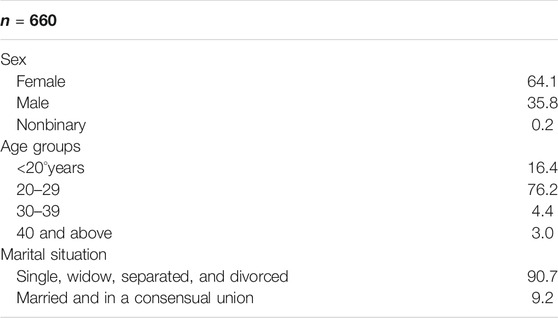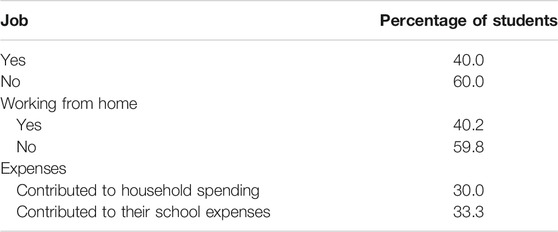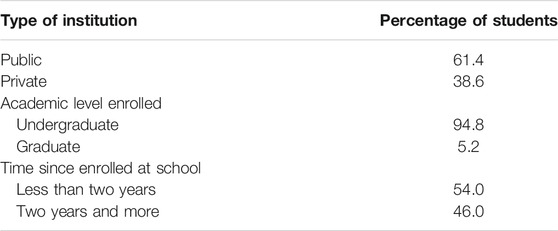Mexico’s Higher Education Students’ Experience During the Lockdown due to the COVID-19 Pandemic
- 1Healthy Border Program, US-Mexico Border Heath Commission, Tijuana, Mexico
- 2Facultad de Humanidades y Ciencias Sociales, Universidad Autónoma de Baja California, Tijuana, Mexico
- 3Secretaría de Salud, Tijuana, Mexico
- 4Universidad Pedagógica Nacional, Tijuana, Mexico
- 5Facultad de Contaduría y Administración, Universidad Autónoma de Baja California, Tijuana, Mexico
- 6Escuela Internacional de Negocios, Universidad Anáhuac, Cancún, Mexico
Transition from face-to-face to remote courses in Mexico represented a challenge for teachers, students, and parents from all education levels. The Mexican federal government declared phase two of the plan to reduce COVID-19 spread on March 24, 2020. In some states, mobility restriction measures started by March 17 included the education system. On April 13, educational activities began in the remote mode exclusively, and this situation could be extended until the end of the 2020–2021 cycle, if health conditions do not improve. Universities, teachers, and students were not ready to implement the emergency remote teaching (ERT) strategy because of the limited conditions of technological adaptation and digital connectivity in the country. The purpose of this cross-sectional study is to investigate the experiences of graduate and undergraduate students concerning the change from face-to-face to the ERT modality in the health emergency context due to the COVID-19 outbreak. We collected data from 660 students from 38 universities and 22 states across the country. The study investigated students' previous experience with online courses, technological tool use, barriers faced during the new teaching–studying modality, current use of educational and specialized tools, and some physical and mental health indicators. As a result, we found problems related to time management of their work activities, the balance of time between home and school activities, and perception about studying days, which they felt strenuous. More than half of all students reported Internet connection problems. Students from private universities declared a higher use of technological tools. Students from public universities expressed more significant difficulties following teachers' instructions, perceived less attention from teachers, considered the change to remote courses was difficult, and felt overwhelmed by the required technological skills. Students in the first two years of university reported a higher proportion having deemed the most strenuous study days and having had difficulties following the teachers' instructions and considered that the distance modality change was hard. Finally, all the students declared that the expenses increased in their home in the highest proportion were electricity, mobile phone data, and Internet service. Future research should focus on measuring the impact of ERT on students’ learning outcomes.
Introduction
COVID-19 placed the Mexican educational system, like the rest of the world, in an emergency. On March 24, 2020, Mexico’s federal government declared phase two of the plan to address the country’s COVID-19 outbreak; this included the cancellation of face-to-face academic activities. These changes profoundly impacted university dynamics and presented a challenge for students, teachers, their families, and the university system in general. These changes, which have caused a significant adjustment in the daily routine, require students and teachers to adapt to online learning platforms and modify all face-to-face academic activities (Debbarma and Durai, 2021). Restrictions on mobility and transition to the remote modality caused tension, anxiety, depression, and stress in all participants (Jakovljevic et al., 2020), and students have been one of the groups most affected by the pandemic (Kannarkat et al., 2020; Wang et al., 2020). Also, the remote modality requires more significant commitment and discipline from students (UNESCO, 2020). Besides, the country’s technological and digital infrastructure was not in the condition to face the emergency (Fernández et al., 2020).
The number of students registered at undergraduate and graduate levels in Mexico was 4.93 million in the 2019–2020 school year, of which 17.36% (869.6 thousand) were out-of-school students who already obtained their education online (Asociación Nacional de Universidades e Instituciones de Educación Superior (ANUIES), 2020); approximately one out of five students are unfamiliar with this learning modality. Online learning is a new concept for students and teachers (Debbarma and Durai, 2021). However, online education in Mexico increased in the last 25°years (Moreno, 2015), and before the health emergency, virtual education was already present in the largest higher education institutions. Current virtual education is a way to improve skills and learn among university students (Duran, 2015). In addition, this type of education allows greater flexibility in their access (Hernández et al., 2018) and provides university students greater autonomy in their schedule and time management (Vlachopoulos and Makri, 2019).
In response to COVID-19, the university has been challenged in all aspects. Teaching practice faced the need to use technological tools to provide distance learning in response to a crisis and characterized using tools that give instruction remotely rather than in person. This strategy has been known as the emergency remote teaching model, whose primary objective has been to provide temporary access to education using tools that allow quick and reliable access; in contrast, the conditions leading to an emergency exist (Hodges et al., 2020). This model emphasizes teaching and meets the demands of higher education institutions, and the student has a passive role.
It has not been easy for a student and teacher to adapt to having class at home. Teachers and students of all educational levels and their families have had to adjust and find spaces to conduct their courses at home (Muñoz and Lluch, 2020). Students face the challenge of setting up a study area in their house equipped with books, computers, and fast Internet access (Sahu, 2020). Among Mexican students, 39.1% lack Internet service; of all Mexican households by 2020, 44.3% had computers and 56.4% had access to the Internet, with slow information transfer (50.1%) and constant service interruptions (38.6%) (Instituto Nacional de Estadística y Geografía- INEGI, 2020). Studies show that up to 30% of students must access their assignments via cellphone (Portillo et al., 2020); furthermore, students from families with a low educational level have fewer opportunities to utilize digital technologies (Pérez-López et al., 2021). Due to sudden changes, accelerated digitization, and students’ limited resources, there is a digital gap, and students cannot use technology (BID, 2020).
Families’ routine has been affected by the intersection between work at home and studying with virtual media (Valdivieso-Miranda et al., 2020). The presence of sick, people with disabilities, or even deceased family members adds additional stress to home dynamics (Íñiguez-Berrozpe, 2020). However, studies have demonstrated that university students who live with their parents have a protective factor (Zhai and Du, 2020), especially if they live in a structured and stable home (Íñiguez-Berrozpe, 2020).
Many students have also faced financial difficulties due to job losses (Samaniego, 2020), which brings more stress (Brooks et al., 2020). Throughout March and December 2020, 440 thousand young Mexicans aged between 15 and 29 lost their jobs and could not regain their jobs (Raziel, 2021). Young people have lost their jobs and their income, and their educational programs have been interrupted. They now face greater difficulty obtaining employment in the future because of COVID-19 (OIT, 2020). Online classes are not popular with students, as they consider them less effective. There are reduced interactions with their classmates, and knowledge transfer is diminished. It is more challenging to solve questions. Technology makes it easier for students to be distracted and less comfortable participating in the discussion. Simultaneously, technical difficulties obstruct and disrupt the class flow, making participation in the debate less comfortable (Nambiar, 2020). Students have experienced little interaction with peers, communication with teachers is weak, and communication with the institution is almost nil (Debbarma and Durai, 2021). Students prefer face-to-face classes; 65% consider it more effective (Bhaumik and Priyadarshini, 2020).
Based on that mentioned above, we conducted a study to gather information on students’ experience with emergency remote teaching. This study is relevant because there is a need to have empirical evidence on the impact of confinement and the change to a remote teaching model on university students. Mexico’s health authorities defined face-to-face academic activities will return once the COVID-19 epidemiological risk is deemed low (Ministry of Health, 2020); to date, courses at all educational levels will continue in the remote model at least until the end of the first semester of 2021.
Materials and Methods
This study shows the results of a cross-sectional, exploratory, nonexperimental, and descriptive study through an online questionnaire. Among higher education students and teachers in Mexico, this study highlighted the difficulties they experienced while implementing the emergency remote teaching program resulting from the COVID-19 pandemic. In this study, we consider that there may be significant differences between students’ experiences from public and private educational establishments and between recently admitted students and those with more than half of their degree completed. Results of teachers’ experience research are described in another manuscript from the same research team (Zapata-Garibay et al., 2021); the current document presents students’ experience due to the teaching–learning change model.
Sample
This study implemented a snowball sampling technique to recruit higher education students from public and private institutions in Mexico. We decided not to develop a case study in a particular university after identifying the difficulties of having access to a list of all the students to use a random sampling technique (Etikan et al., 2016). With the snowball sampling technique, we were able to recruit students from a greater diversity of universities, geographical areas, and areas of knowledge of the participants. The inclusion criteria were to be a higher education student enrolled between January and July 2020. The target population includes undergraduate, master, doctoral, and specialty students.
Data Collection Instrument
To design the study and collect the data, we integrated a team of full-time teachers and lecturers from public and private universities in Mexico. The questionnaires were elaborated based on the researchers' experiences gained after the emergency remote teaching implementation and adapted some validated questionnaires (Sánchez et al., 2020). In addition, we adapted the Teachers Stress Scale (ED6) to measure stress in higher education instructors (Gutiérrez-Santander et al., 2005) and was adapted for higher education students. We developed two separate questionnaires to collect data for each population (students and instructors) to contrast perspectives from both groups about the same phenomena. The student questionnaire’s objective was to explore graduate and undergraduate students’ experiences related to the change from face-to-face modality to the emergency remote teaching model implemented nationwide.
In the questionnaire, we collected students’ demographic characteristics: age, gender, marital status, housing situation and cohabitation status, household composition, care of children, elderly and persons with disabilities, and state and city of residence. Regarding the academic institution, we inquired about the institution’s name, level of training, the area of knowledge, the number of classes taken during the semester, and academic program's name. Also, we asked about students’ employment status between January and June 2020, if they were working from home, the kind of work they do, contribution to household expenses, and the primary source of household expenses.
Another questionnaire section was dedicated to asking students about the resources for online courses at their university. We also asked about their skills and abilities associated with using communication technologies and technological tools. Technical adaptation is expressed by electronic equipment availability, adequate Internet connectivity, and logistical transformation manifested in spaces suitable for taking classes at home. Related to these questions, we asked students about the remote study’s current conditions: technological, logistical, and barriers associated with the shift to online classes. The last two sections of the questionnaire were dedicated to health: we included questions regarding students and their families’ COVID-19–related risk factors, symptoms, and signs of anxiety, depression, motivation, and satisfaction. Additionally, we asked about interpersonal relationships with their family associated with the shift to remote learning. This entire set of questions allowed us to better understand the students’ conditions during the lockdown and emergency remote learning context.
Data Collection
Data collection was carried out using an online Google Forms questionnaire from June 20 to December 14, 2020. We sent an invitation to participate in the study to teachers and students associated with the Binational Border Health Network and other colleagues. The invitation included a brief description of the study, its objectives, and its scope. Participants were also invited to share the online questionnaire among their contacts to increase the sample size.
Participants agreeing to join the study gave their informed consent to provide the study’s information and consented to use such data for statistical analysis purposes. Names, email addresses, or other ways to identify the respondents were not asked.
Data Analysis Strategy
Data were exported and analyzed using SPSS version 25.0 (IBM Corporation). Descriptive statistics were presented as counts and percentages to summarize the collected data.
As a data analysis strategy, we stratified the students by the institution type in which they are enrolled, public or private, and enrollment time. We chose these variables since we assume that private institutions’ infrastructure level encourages students to have greater familiarity with these technologies. On the other hand, the time enrolled in the university has a differential effect on the students’ experience. First- and second-year students tend to have elevated levels of mental distress and anxiety (Naser et al., 2020).
Results
Among the 784 responses we received, we excluded 124 due to ineligibility because the students were not enrolled in school between January and June 2020; this left 660 completed questionnaires, which contributed to an 84.2% response rate. Of these, 88.1% of the participants live in four states of the Mexican Republic, out of 22 states represented in the study. The states with the largest participation were Baja California (53.9%), Quintana Roo (15.5%), Tamaulipas (14.1%), and Zacatecas (4.5%). Students from more than 38 universities across the country participated; they are enrolled in 59 undergraduate programs, 15 master’s degree programs, one specialty, and five doctorate programs. Regarding the discipline in which the students are enrolled, the highest participation was of students from the areas of psychology (20.5%), economic and administrative sciences (16.7%), political sciences (12.0%), medicine and human pathology (11.5%), and agronomic and veterinary sciences (4.8%). The remaining 34.5% declared a wide variety of disciplines.
Demographic Characteristics of Participants
Of the 660 participants, 64.1% were women. The participants ranged in age from 18 to 66°years (mean ± SD = 22.74 ± 5.64°years). 32.7% of the participants were between 18 and 20°years of age, and 40.9% were in the age group of 21–29°years. Most participants reported that they were not engaged in a consensual union (90.7%) (Table 1).
Job Profile of Participants
According to the students’ work profile, 40.0% worked, of which 59.8% did not work from home during confinement. Of the total number of students, 30.0% declared that they contribute with household expenses, and 33.3% contribute partially or totally with the payment of their school expenses (Table 2).
Type of Institutions, Academic Level, and Time Enrolled
61.4% of the students were in public higher education, 94.8% were enrolled in undergraduate courses, and 54.0% were in their first two years of studies (Table 3).
From this point, we present the data analysis based on the type of institution, public and private, and the time that the student has been enrolled in the university, less than two years or two years and more.
Digital Conditions of the Institutions and Students’ Skills Before the Change of Remote Teaching Modality
Students from private universities reported in a large proportion that their universities have virtual campuses available (65.1%). On the other hand, students from public schools reported a higher percentage to know that their universities offered online courses (59.8%), and these courses were already part of the curriculum before the confinement (43.0%). Students who had spent two or more years in the university reported in a higher proportion that their academic institutions offered virtual campuses (65.5%) and online courses (68.3%) and these courses were a part of the subject (46%).
In terms of previous skills, students from public universities had a better record for familiarity with educational platforms (76.8%) and distance education (63.5%) and have taken online classes (41.5%). In contrast, private school students performed better with distance assessment (43.1%). The students with more than two years of enrollment are more likely to declare that they possess the necessary skills to function in digital media. Some of these include the use of educational platforms (81.7%), use of distance education tools (63.4%), previous experience with online courses (50.0%), and remote assessment (48.2%) (see Table 4).

TABLE 4. Digital conditions of the students’ institutions and skills before the change from the model to remote teaching, by type of institution and enrollment time at school.
Use of Technological Tools to Support the Students’ Learning Process Before the Emergency Remote Teaching Model Implementation
The use of tools by students from private universities was more than 17 percentage points higher than students from public universities; the provision of devices of this nature corresponds to the institutions themselves. The difference was 8.6 percentage points in communication tools, 19.5 in academic platforms, 6.9 in storage tools, 4.6 in synchronous work, and 3.3 in video tools.
Regarding the differences between students, based on their time expended in college, those who have been more than two years in college reported more extensive use of technological tools than those in their first two years of college. This last group reported a greater extent (84.1%) in communication tools (Figure 1).
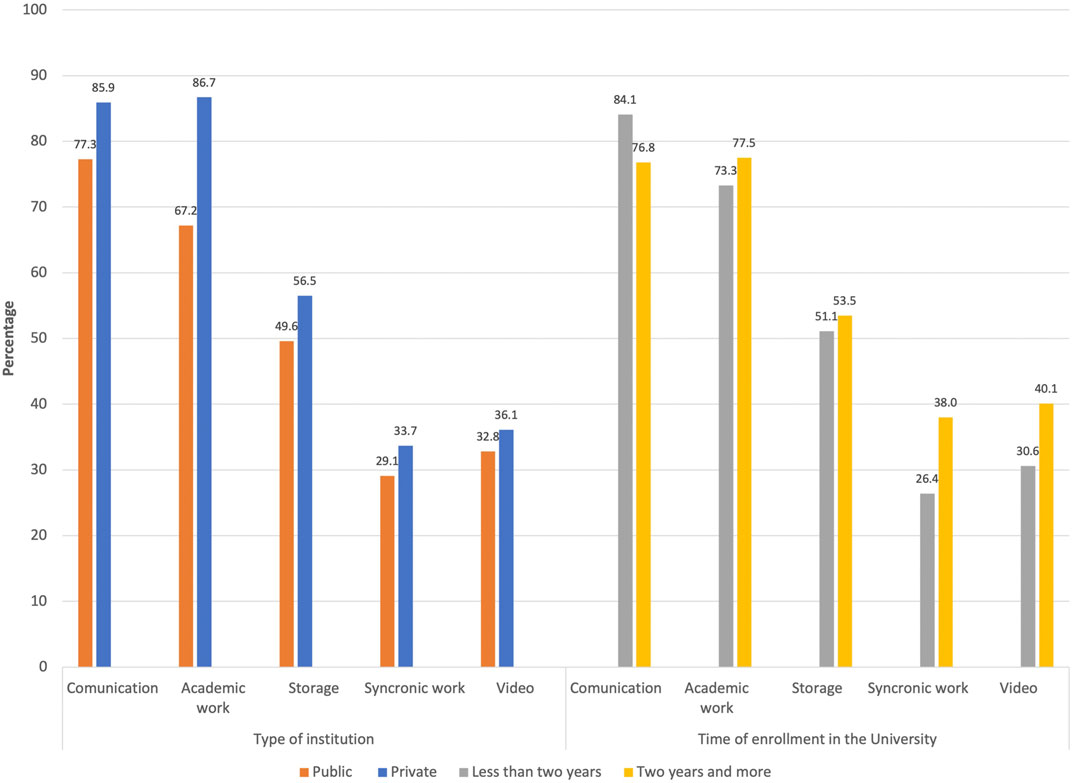
FIGURE 1. Use of technological tools to support students’ learning process before the emergency remote teaching model implementation, by type of institution and time of enrollment in the university.
Technological, Connectivity, and Logistical Conditions in the Students’ Learning Process, Before the Emergency Remote Teaching Model Change
In the study, we collected information on five technological indicators, two related to Internet connectivity and three for logistical adjustments. In seven out of the ten indicators, students from private institutions had better conditions than those from public universities. Regarding the endowment indicators for equipment, students from private universities were found to be in better conditions, with a difference of around three percentage points between students from different categories of universities. The difference in access to Internet connection between students is 3.3 percentage points. The students from private universities are in better conditions, and connectivity problems difference is 1.5 percentage points, which should be linked to connectivity problems at the national level resulting from the increased demand for Internet service to work and study at home. Students from public universities presented better conditions in three categories: availability of cell phones, having a study desk and a quiet place without distractions, and having reference materials at home. Although the differences were slight, Internet connections for students from private universities were also better (Figure 2).
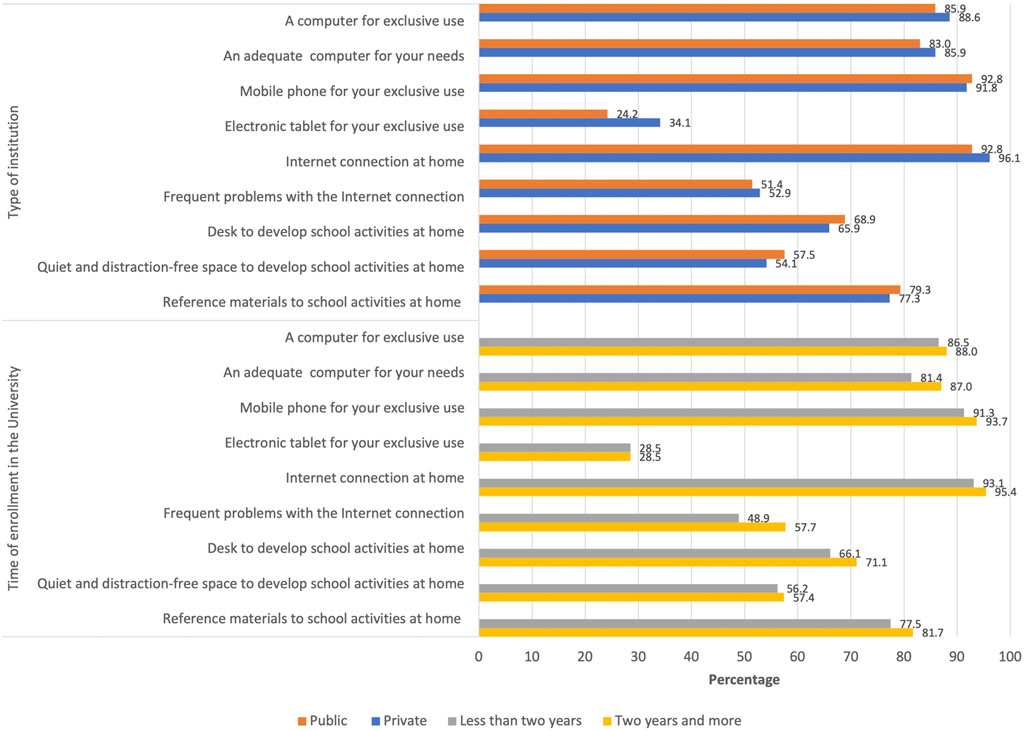
FIGURE 2. Technological, connectivity, and logistical conditions among students, before the emergency remote teaching model implementation, by type of institution and time of enrollment in the university.
According to the university enrollment time, the students with a longer time on campus declared a higher proportion in all the indicators presented, except for having an exclusive electronic tablet. The differences observed in various cases were significant. However, the differences in most cases were slight. In the first instance, students with high marks were regularly experiencing problems with their Internet connection and having a computer suitable for their academic needs’ activities. They registered differences of between 6 and 8 percentage points.
Use of Digital Technology Tools During Current Academic Work
Students from private institutions had better conditions than students from public universities in the five technological tools analyzed. Students from the two groups have a range of differences between 9.9 and 16.4 percentage points, where synchronous work tools are the most notable difference. Students enrolled in their first two years of their university studies use the most technological tools for communication, academic work, storage, and video; only those who have been in the university longer than two years have the advantage of synchronous tools.
Current Use of Technological Tools for Studying
The five categories of tools have increased in most cases between the current study conditions and the conditions before the change of study modality. The most significant variation occurs in synchronized work tools, with students from private universities reporting 47.9 percentage points to increase; for students from public schools, the increase was 41.8 percentage points. For video tools, private school students saw increases of 30.6 percentage points, while public school students saw gains of 23.0 percentage points. Changes like these can be because classes are now taken synchronously via Internet, where the video is almost mandatory. Based on their school enrollment time, the greatest changes were in synchronous work and video tools. The other tool that changed significantly is video, which increased by 29.8 percentage points in students with less than two years in college and 18.7 percentage points in students with more than two years in college (Figures 1, 3).
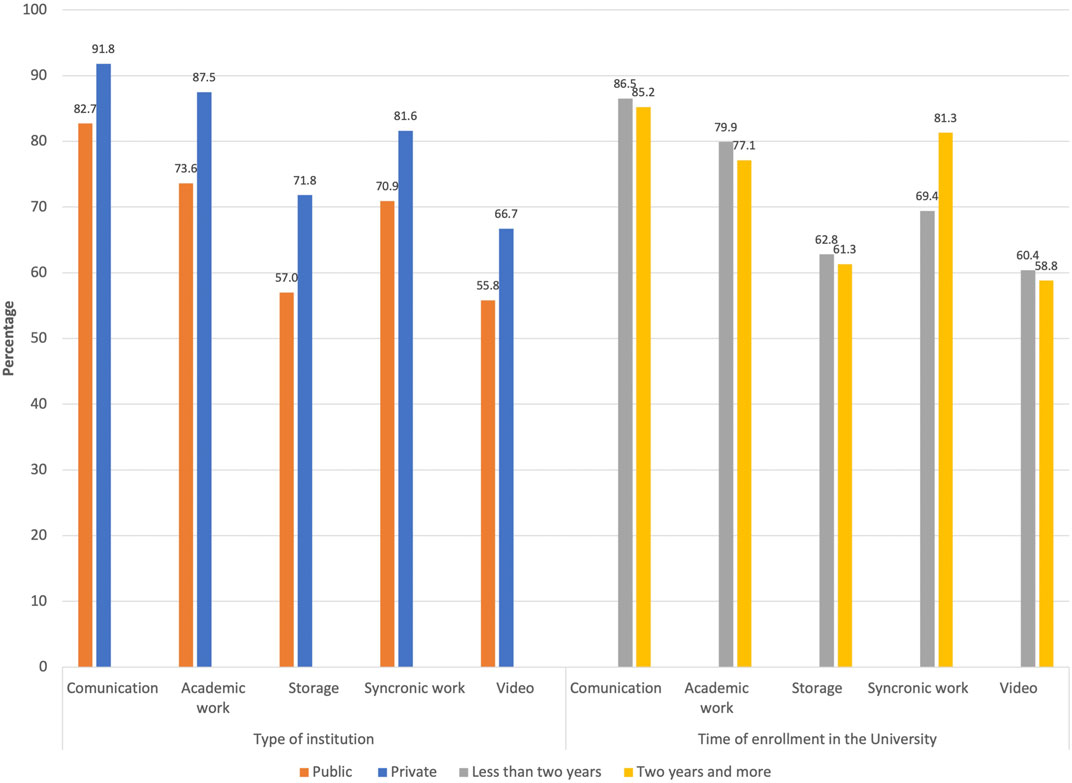
FIGURE 3. Use of technological tools to support students’ learning process during the emergency remote teaching model implementation, by type of institution and time of enrollment in the university.
Current Conditions of Technology and Internet Connection
Private university students presented the best technical conditions due to their greater provision of computers (89.4%), mobile phones (97%), electronic tablets (29.4%), iPads (97%), and video and audio recording equipment (33.3%). In some cases, the difference was up to nine percentage points. We also want to emphasize the frequent problems students have with their Internet connections at home; in both cases, more than half of the students interviewed reported having such issues. Students who have been enrolled in their higher education for a larger period have higher percentages of technology access than those enlisted for a shorter time. However, the differences are between two and three percentage points (Figure 4).
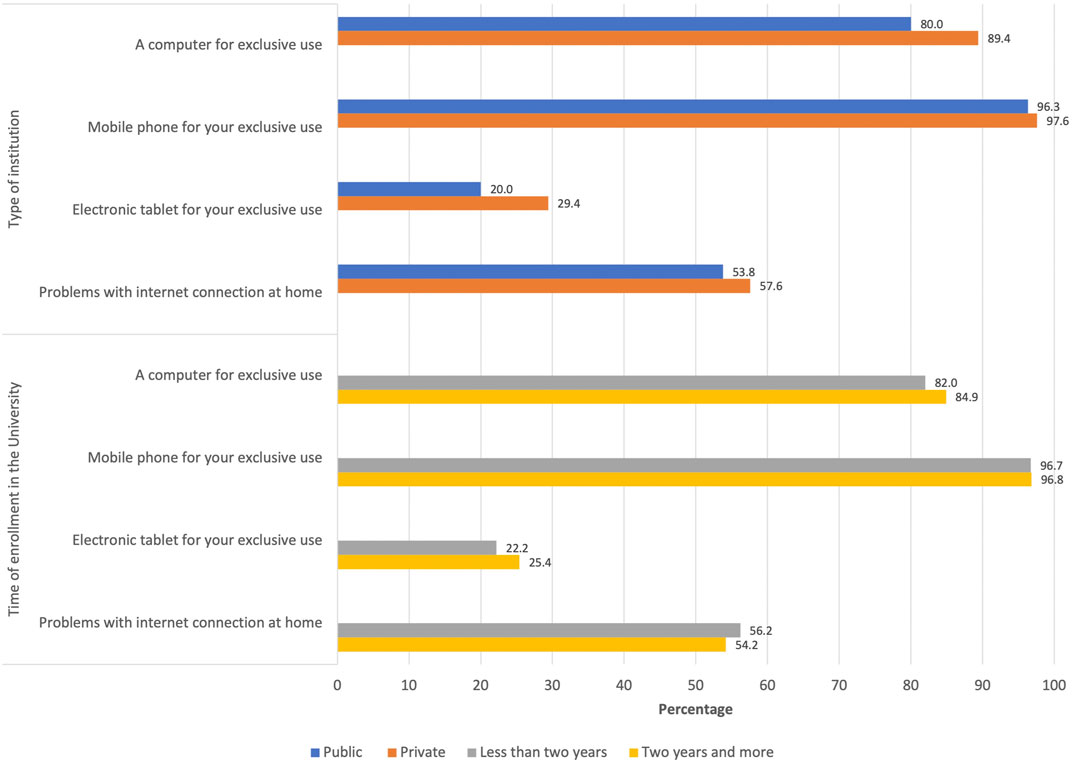
FIGURE 4. Technological and connectivity conditions among students during the emergency remote teaching model implementation, by type of institution and time of enrollment in the university.
Current conditions show that exclusive computer use and electronic tablet endowment decreased for students at public universities, suggesting that they must share it with other household members. The same situation is observed in electronic tablets for exclusive use for students at private universities (Figures 2, 4).
Current Problems in Students’ Learning Process Before the Change of Model to Remote Teaching
As the students’ problems are identified based on their institution types, it is noted that there are no important differences between the two groups. Among public university students, there were higher rates of problems balancing their time between school and home activities (65.4%) and difficulties communicating with school authorities (46.9%). On the other hand, students from private universities had greater difficulty managing the time dedicated to school activities (58.8%) and managing the time devoted to school tasks (63.9%).
Students enrolled in the first two years of the university, reported a higher proportion of difficulty balancing school and homework (66.7%), problems organizing the time dedicated to the assignments (63.1%), and difficulties managing their time to carry out school activities (60.1%). On the contrary, students in the last couple of years reported more difficulty communicating with school authorities (46.5%) (Figure 5).
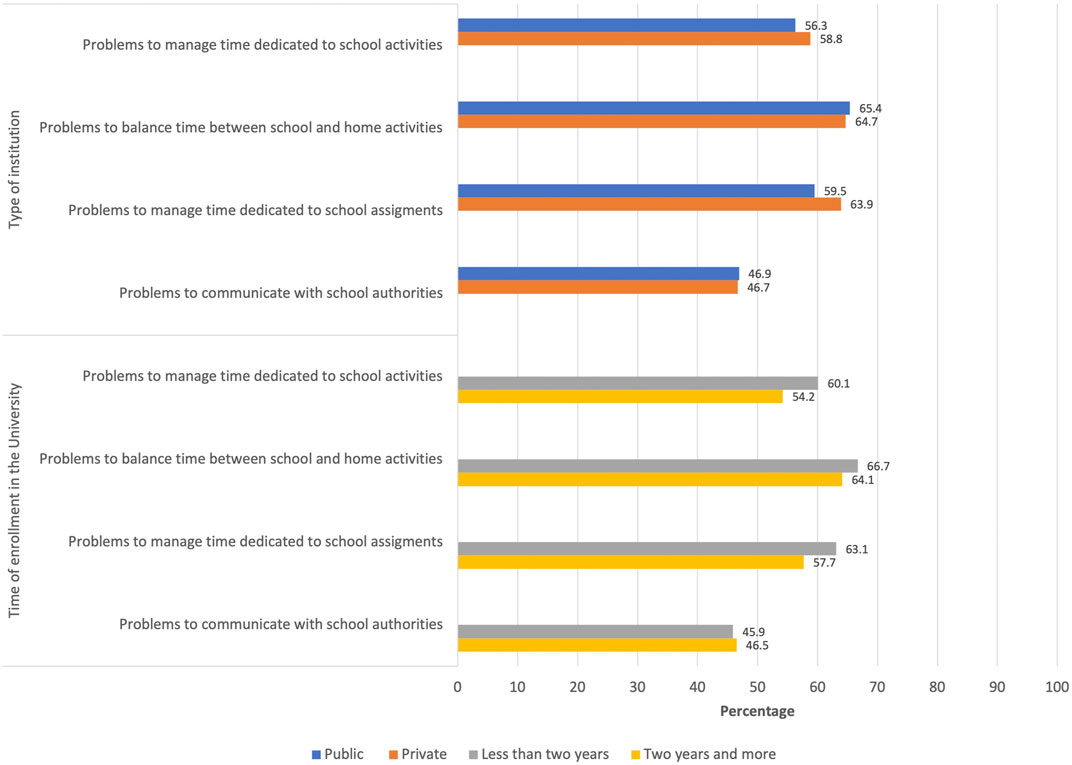
FIGURE 5. Problems related to school activities before the emergency remote teaching model implementation, by type of institution and time of enrollment in the university.
Barriers Faced by Students in the Shift to Remote Learning
Students from public universities reported more difficulties with the learning process after the remote education model implementation, mainly in following teachers’ instructions (57.5%), perceived less attention from the teachers (55.3%), and consider the shift to online classes to be difficult (52.3%), as well as feeling overwhelmed by the technological skills demanded by the teachers (38.8%). On the other hand, students in private universities expressed they felt attacked by their teachers’ attitude (31.4%). A substantial difference between the two groups of students results from the perception that they received less attention from the teachers; this marked difference is 7.5 percentage points. Both groups of students expressed the most robust agreement regarding the study days being strenuous (68.6% in both cases).
Students that have expended less than two years at the university reported higher levels of fatiguing study days (70.0%). Additionally, these students registered in a large proportion having difficulties following teachers' instructions (57.1%), consider the change to the remote mode as complex (56.8%), have felt overwhelmed by the technological skills required by teachers or the courses (40.2%), and have felt attacked by the actions or attitude of their teachers (26.4%). On the other hand, students who have been in university for more than two years reported receiving less attention from instructors (53.2%). It is important to highlight that, in both cases, the problem with the highest proportion was having perceived the study days as strenuous (Figure 6).
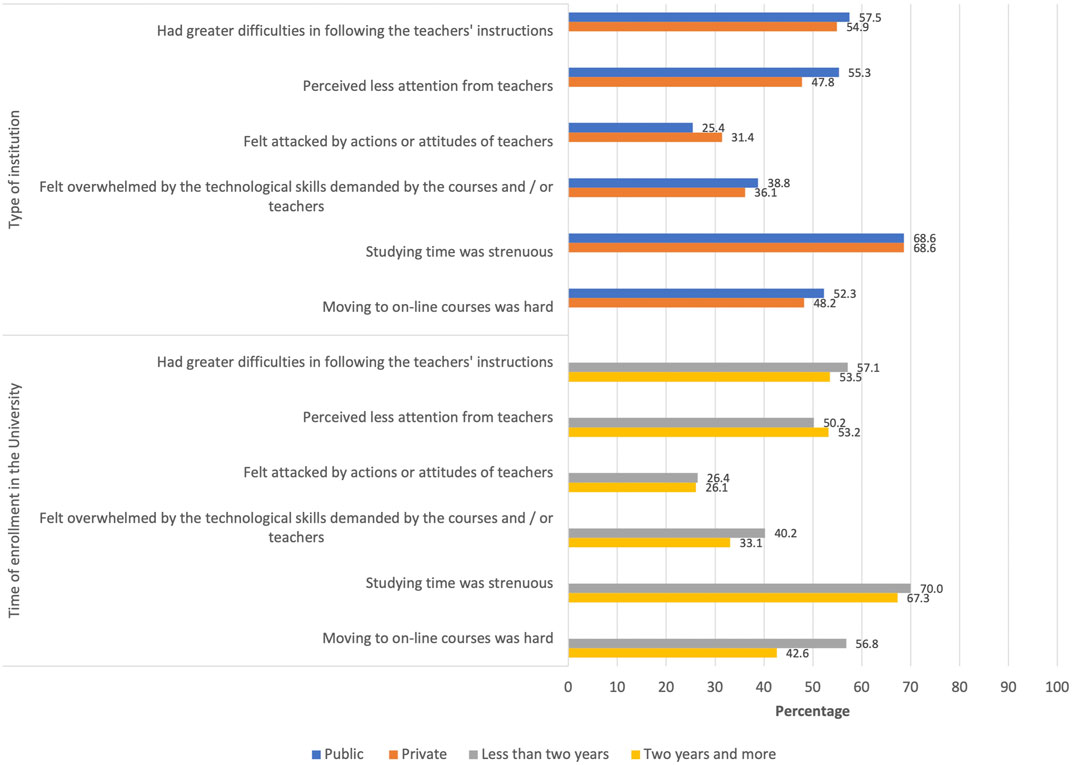
FIGURE 6. Problems faced by students during the emergency remote teaching model implementation, by type of institution and time of enrollment in the university.
Economic Impact on Students due to the Shift to Remote Learning
In two out of eight indicators consulted, the students at public universities reported a greater proportion of their home expenses increased, buying or repairing electronic devices (43.0%) and photocopies or printing (24.7%). The students from private universities said the highest expenditures in their homes in proportion were electricity (76.9%), mobile phone data (56.1%), and Internet service in their homes (52.9%). The most remarkable differences between both groups of students are in the electricity payment with a difference of 8.5 percentage points and mobile phone communications with a difference of 8.4 percentage points. In both cases, the electricity cost was the most mentioned issue by the students.
Students who had completed less than two years of the program exhibited higher proportions in all areas when compared to those who had achieved more than two years: increased spending on electricity (72.4%), Internet payments at home (56.2%), mobile phone data (53.5%), purchase or repair of electronic equipment (43.5%), subscriptions to videoconferencing and storage platforms (27%), additional training to improve communication skills (25%), photocopies and printing (22%), and the purchase of materials (21.6%). While the differences were slight in some cases, the biggest difference was in the increase in spending for Internet payments at home. A 15-percentage point gap in this indicator exists between students studying in their first two university years and those enrolled at the university last years (Figure 7).
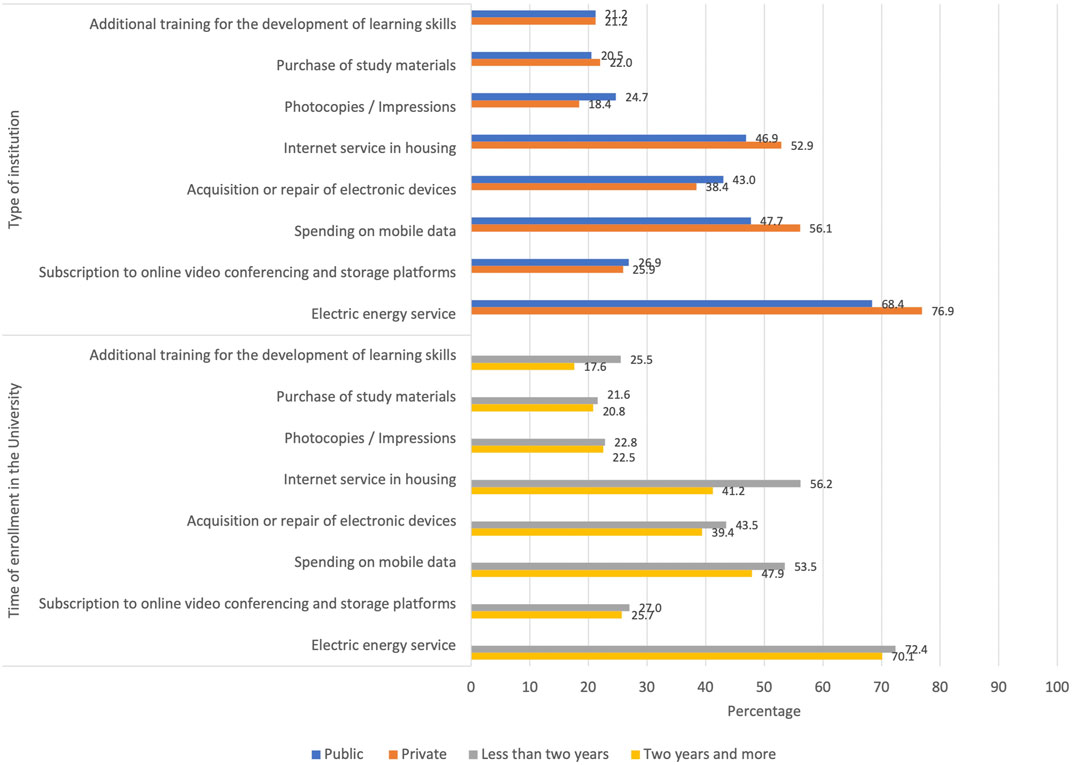
FIGURE 7. Household expenditures increased reported by students due to the emergency remote teaching model implementation, by type of institution, and time of enrollment in the university.
Discussion
During COVID-19’s emergence, education was one of the sectors impacted by the actions taken to contain the pandemic. The health and education authorities decided to implement a remote teaching model for emergencies, moving from in-person classes to remote courses utilizing radio, television, and learning management systems. This change has revealed deficiencies and inequities in education systems, Internet access, and computer equipment for online education. Since students from highly marginalized groups do not have access to digital learning resources and show lack of resilience or self-learning skills, they may be at risk of lagging behind their peers (Schleicher, 2020).
Several studies have discussed the challenges in adopting the emergency remote education model in response to the outbreak of COVID-19 in teachers, noting that not everyone was ready for the change. Although teachers and students acquire individual skills on the fly, an important aspect is the infrastructure and technological capacity previously available in universities. This situation indicates the degree of exposure that academic staff and students have to these kinds of tools.
The data presented in this study demonstrate that the inequalities mentioned above play a significant role in accessing and using information and communication technologies (ICTs). A significant benefit of using ICTs in teaching is that asynchronous and synchronous methods combine to promote information transmission, active learning, and student participation (Sunasee, 2020). This study illustrates the increase in the use of ICTs between the beginning of confinement and the end of the school term; however, we do not have sufficient data to assess their effect on the students’ academic performance who took the survey.
Furthermore, having a job could adversely affect the students’ performance during confinement. Before the outbreak, increasing work hours result in fewer hours spent studying, resulting in lower academic performance (Logan et al., 2016), particularly when students must have a job to support themselves financially (Wenz and Yu, 2010). In the current study, fewer than half of the students reported that they had a job, and a proportion of them said that they had worked from home during pandemic confinement. As workers have shown difficulty concealing the working day and ensuring clear delimitation between work and nonwork time (Dockery and Bawa, 2020), this situation could result in a longer workday and, hence, a shorter study time in those cases when the worker is a student too.
Based on this study survey, students reported difficulties during the first few months of emergency remote education, mainly those related to balancing their time between work and school activities. It could be that being confined at home and being asked to do more household chores due to having spent so much time in the same household may have contributed to a feeling of overwhelming.
Lastly, students reported increasing expenditures when academic activities were moved to their homes; most of the costs are related to electrical energy, the acquisition/repair of electronic devices, the Internet at home, and mobile data usage, all about online academic work. The change could also be attributed to the lack of equipment and Internet access before beginning the emergency remote education program, which had to be acquired by the students to utilize the necessary tools for their academic activities. This result agrees with Raheim’s (2020) analysis of Indonesia which shows the problem is worldwide and mainly in countries with a lower level of development.
Conclusions
The current document presents the results of a broader study looking for information on the impact of a shift to the remote teaching model as a part of the worldwide initiatives to curb the spread of COVID-19. As we did not use a random sampling method to select and recruit participants for this study, the results are not generalizable to the country’s entire higher education students’ population. However, we consider that the obtained results provide relevant information on the students’ conditions through the emergency remote teaching model implementation in Mexico.
Students faced some unfavorable conditions based on the data collected when emergency remote education was first implemented in Mexico. Studies have demonstrated these conditions are not only prevalent in this country but also occur worldwide, with varying levels of intensity, and repeatedly expose inequality, manifesting themselves in unfavorable study environments that hinder high-level students.
Study results indicate that some limitations exist regarding the impact of confinement and changing teaching approaches on student performance and perceptions of acquired knowledge. It is important to note that our study included only students who continued their studies during the remote teaching period. However, we agree that students who chose to drop out of school could be included in measuring the pandemic’s impact on higher education students. There is no doubt that future investigations on this subject should consist of both components, considering that the confinement has not yet ended.
There is agreement among the writers of this article that more research must be conducted to better understand the effects of COVID-19 on education in Mexico, using random sampling methods to generalize the results to the general population. Students have been facing diverse conditions before COVID-19; some enrolled in the university earlier and have had to adjust to the new reality of remote teaching. Those who registered after the start of the pandemic have not experienced face-to-face courses at the university.
We hope that this study will contribute knowledge about the pandemic’s impact on higher education in Mexico, particularly from the students’ views about how they encountered a new teaching model and the faced difficulties.
Contributions to Knowledge
COVID-19 outbreak started as a public health emergency, but it quickly became apparent that its impact will appear in the social arena. This article looks to generate knowledge about the pandemic’s impact on higher education in Mexico, particularly from the students’ views on how they faced a new teaching model and their main difficulties. After a year into the lockdown, a reduced number of studies analyzed the consequences it has had and will have in the short, medium, and long term in Mexico. Notably, the main concern is how students’ academic performance will be affected. Providing new knowledge about this topic, we expect to discuss the need to start considering the strategies that education authorities should implement to mitigate the abovementioned impact.
Data Availability Statement
The raw data that support the conclusions of this article will not be available until the authors conclude the analysis they are currently working on for upcoming publications.
Ethics Statement
This project received approval by the ethics committee established by the Mexico Section of the US-Mexico Border Health Commission. A de-identified database was part of the data analysis; the analysis of the data did not include any personal information or any other way to identify the participants.
Author Contributions
RZ-G: lead author, study conception and design, compiled/collected data, data analysis, manuscript writing, critical revision of the manuscript, and final approval of the version being published. JG-F: coauthor, study conception and design, compiled/collected data, data analysis, interpretation of data, manuscript writing, critical revision of the manuscript, and final approval of the version being published. EM-R: coauthor, manuscript writing, critical revision of the manuscript, and final approval of the published version. ES-R: coauthor, manuscript writing, critical revision of the manuscript, and final approval of the published version. IP-L: revision of the manuscript, and final approval of the version being published. CG-F: coauthor, revision of the manuscript, and final approval of the version being published.
Conflict of Interest
The authors declare that the research was conducted in the absence of any commercial or financial relationships that could be construed as a potential conflict of interest.
Acknowledgments
The authors thank all the teachers who participated in this study and the colleagues who supported its dissemination.
References
Asociación Nacional de Universidades e Instituciones de Educación Superior – ANUIES. (2020). Estadística de Educación Superior, Ciclo escolar 2019-2020. Retrieved from http://www.anuies.mx/informacion-y-servicios/informacion-estadistica-de-educacion-superior/anuario-estadistico-de-educacion-superior (Accessed November 10, 2020).
Banco Interamericano de Desarrollo-BID (2020). La Educación Superior en tiempos de COVID- 19. Washington, DC, USA. Retrieved from https://publications.iadb.org/publications/spanish/document/La-educacion-superior-en-tiempos-de-COVID-19-Aportes-de-la-Segunda-Reunion-del-Di%C3%A1logo-Virtual-con-Rectores-de-Universidades-Lideres-de-America-Latina.pdf.
Bhaumik, R., and Priyadarshini, A. (2020). E-readiness of Senior School Learners to Online Earning Transition amid COVID-19 Lockdown. Asian J. Distance Educ. 15 (1), 1–13. doi:10.5281/zenodo.3891822
Brooks, S. K., Webster, R. K., Smith, L. E., Woodland, L., Wessely, S., Greenberg, N., et al. (2020). The Psychological Impact of Quarantine and How to Reduce it: Rapid Review of the Evidence. The Lancet 395 (10227), 912–920. doi:10.1016/s0140-6736(20)30460-8
Debbarma, I., and Durai, T. (2021). Educational Disruption: Impact of COVID-19 on Students from the Northeast States of India. Child. Youth Serv. Rev. 120, 105769. doi:10.1016/j.childyouth.2020.10576
Dockery, M., and Bawa, S. (2020). Working from Home in the COVID-19 Lockdown. Bentley: Bankwest Curtin Economics Centre.
Duran, R. (2015). La Educación Virtual Universitaria como medio para mejorar las competencias genéricas y los aprendizajes a través de buenas prácticas docentes (doctoral thesis). Retrieved from https://www.tdx.cat/handle/10803/397710#page=1 (Accessed October 10, 2020).
Etikan, I., Alkassim, R., and Abubakar, S. (2016). Comparison of Snowball Sampling and Sequential Sampling Technique. Biometrics Biostatistics Int. J. 3 (1), 55. doi:10.15406/bbij.2015.03.00055
Fernández, M., Herrera, L., Hernández, D., Nolasco, R., and de la Rosa, R. (2020). Lecciones del Covid-19 para el sistema educativo mexicano. Nexos, distancia por tiempos, blog educación. Retrieved from: https://educacion.nexos.com.mx/?p=2228 (Accessed October 10, 2020).
Gutiérrez-Santander, P., Morán-Suárez, S., and Sanz-Vázquez, I. (2005). El estrés docente: elaboración de la escala ED-6 para su evaluación. Relieve: Revista Electrónica de Investigación y Evaluación Educativa 11 (1), 2. doi:10.7203/relieve.11.1.4196
Hernández, V., Fernández, K., and y Pulido, J. (2018). La actitud hacia la educación en línea en estudiantes universitarios. Revista De Investigación Educativa 36 (2), 349364. doi:10.6018/rie.36.2.277451
Hodges, C., Moore, S., Lockee, B., Trust, T., and Bond, A. (2020). The Difference between Emergency Remote Teaching and Online Learning. EDUCAUSE. Retrieved from: https://er.educause.edu/articles/2020/3/the-difference-between-emergency-remote-teaching-and-online-learning (Accessed November 8, 2020).
Íñiguez-Berrozpe, T. (2020). Universitarios y Confinamiento. Factores Socio-personales que Influyen en sus Niveles de Ansiedad y Empatía. Revista Internacional De Educación Para La Justicia Soc. 9 (3), 301–316. doi:10.15366/riejs2020.9.3.016
Instituto Nacional de Estadística y Geografía- INEGI (2020). Encuesta Nacional sobre Disponibilidad y Uso de Tecnologías de la Información en los Hogares (ENDUTIH) 2019. Retrieved from: https://www.inegi.org.mx/contenidos/saladeprensa/boletines/2020/OtrTemEcon/ENDUTIH_2019.pdf.
Jakovljevic, M., Bjedov, S., Jaksic, N. y., and Jakovljevic, I. (2020). COVID-19 Pandemic and Public and Global Mental Health from the Perspective of Global Health Security. Psychiatria Danubina 32 (1), 6–14. doi:10.24869/psyd.2020.6
Kannarkat, J. T., Smith, N. N., and McLeod-Bryant, S. A. (2020). Mobilization of Telepsychiatry in Response to COVID-19—Moving toward 21st-century Access to Care. Adm. Pol. Ment Health 47 (4), 489–491. doi:10.1007/s10488-020-01044-z
Logan, J., Hughes, T., and Logan, B. (2016). Overworked? an Observation of the Relationship between Student Employment and Academic Performance. J. Coll. Student Retention: Res. Theor. Pract. 18 (3), 250–262. doi:10.1177/1521025115622777
Ministry of Health (2020). Lineamiento para la estimación de riesgos del semáforo por regiones COVID-19. Retrieved from: https://coronavirus.gob.mx/wp-content/uploads/2020/10/SemaforoCOVID_Metodo.pdf (Accessed February 20, 2021).
Moreno, M. (2015). La Educación Superior a Distancia en México. Una propuesta para su análisis histórico. En Zubieta, J. and Rama, C. La Educación a Distancia en México: Una nueva realidad universitaria, (3-16). CDMC, Mexico: Universidad Nacional Autónoma de México. Retrieved from: https://www.ses.unam.mx/curso2016/pdf/18-nov-Zubieta_Educacion_distancia.pdf. doi:10.13140/RG.2.1.1440.9360
Muñoz, J., and Lluch, L. (2020). Educación y Covid-19: Colaboración de las Familias y Tareas Escolares. Revista Internacional De Educación Para La Justicia Soc. 9 (3), 1–17. Available at: https://revistas.uam.es/riejs/article/view/12182. doi:10.15366/riejs2020.9.3
Nambiar, D. (2020). The Impact of Online Learning during COVID-19: Students' and Teachers' Perspective. Int. J. Indian Psychol. 8 (2), 783–793. DIP:18.01.094/20200802. doi:10.25215/0802.094
Naser, A. Y., Dahmash, E. Z., Al-Rousan, R., Alwafi, H., Alrawashdeh, H. M., Ghoul, I., et al. (2020). Mental Health Status of the General Population, Healthcare Professionals, and university Students during 2019 Coronavirus Disease Outbreak in Jordan: A Cross-Sectional Study. Brain Behav. 10 (8), e01730. doi:10.1002/brb3.1730
OIT (2020). Empleo juvenil en tiempos de la COVID-19: el riesgo de una “generación del confinamiento”. Lima, Peru: OIT. Retrieved from: https://www.ilo.org/wcmsp5/groups/public/---americas/---ro-lima/documents/briefingnote/wcms_753103.pdf
Pérez-López, E., Vázquez Atochero, A., and y Cambero Rivero, S. (2021). Educación a distancia en tiempos de COVID-19: Análisis desde la perspectiva de los estudiantes universitarios. RIED. Revista Iberoamericana de Educación a Distancia 24 (1), 331–350. doi:10.5944/ried.24.1.27855
Portillo, S., Castellanos, L., Reynoso, O., and Gavotto, O. (2020). Superior Emergency Remote Teaching in the Face of the Covid-19 Pandemic in Middle and Higher Education. Propósitos y Representaciones 8 (3), 1–17. e589 ISSN 2307-7999. doi:10.20511/pyr2020.v8nSPE3.589
Rahiem, M. D. (2020). Technological Barriers and Challenges in the Use of ICT during the COVID-19 Emergency Remote Learning. Universal J. Educ. Res. 8 (11B), 6124–6133.
Raziel, Z. (2021). Los jóvenes, los más afectados: más de 440 mil de entre 15 y 29 años quedaron desempleados en pandemia. Animal político. https://www.animalpolitico.com/2021/01/jovenes-afectados-desempleados-pandemia (Accessed February 16, 2021).
Sahu, P. (2020). Closure of Universities Due to Coronavirus Disease 2019 (COVID-19): Impact on Education and Mental Health of Students and Academic Staff. Cureus 12 (4), e7541. doi:10.7759/cureus.7541
Samaniego, N. (2020). El Covid-19 y el desplome del empleo en México/The Covid-19 and the Collapse of Employment in Mexico. Economía unam 17 (51), 3–6. doi:10.22201/fe.24488143e.2020.51.566
Sánchez, M., Martínez, A., Torres, R., de Agüero, M., Hernández, A., Benavides, M., et al. (2020). Educational Challenges during the COVID-19 Pandemic: A Teachers’ Survey at UNAM. Mexico: Revista Digital Universitaria. https://www.revista.unam.mx/wp-content/uploads/AOP.pdf. (Accessed October 11, 2020)
Schleicher, A. (2020). The Impact of Covid-19 on Education Insights from Education at a Glance 2020. Retrieved from https://www.oecd.org/education/the-impact-of-covid-19-on-education-insights-education-at-a-glance-2020. pdf (Accessed November 8, 2020).
Sunasee, R. (2020). Challenges of Teaching Organic Chemistry during COVID-19 Pandemic at a Primarily Undergraduate Institution. J. Chem. Educ. 97 (9), 3176–3181. doi:10.1021/acs.jchemed.0c00542
UNESCO (2020). Education: From Disruption to Recovery. Available at: https://en.unesco.org/covid19/educationresponse (Accessed November 8, 2020).
Valdivieso-Miranda, M., Burbano-Pantoja, V. M., and Burbano-Valdivieso, A. S. (2020). Percepción De Estudiantes Universitarios Colombianos Sobre El Efecto Del Confinamiento Por El Coronavirus, Y Su Rendimiento Académico. Espacios 41 (42). doi:10.48082/espacios-a20v41n42p23
Vlachopoulos, D., and Makri, A. (2019). Online Communication and Interaction in Distance Higher Education: A Framework Study of Good Practice. Int. Rev. Educ. 65, 605–632. doi:10.1007/s11159-019-09792-3
Wang, C., Pan, R., Wan, X., Tan, Y., Xu, L., Ho, C. S., et al. (2020). Immediate Psychological Responses and Associated Factors during the Initial Stage of the Coronavirus Disease (COVID-19) Epidemic Among the General Population in China. Int. J. Environ. Res. Public Health 17 (5), 1729. doi:10.3390/ijerph17051729
Wenz, M., and Yu, W. (2010). Term-time Employment and the Academic Performance of Undergraduates. J. Educ. Finance 35 (4), 358–374. doi:10.1353/jef.0.0023
Zapata-Garibay, R., González-Fagoaga, J. E., González-Fagoaga, C. J., Cauich-García, J. R., and Plascencia-Lopez, I. (2021). Higher Education Teaching Practices Experience in Mexico, during the Emergency Remote Teaching Derived from the Health Implementation Due COVID-19. Front. Educ. 6, 1–14. doi:10.3389/feduc.2021.628158
Keywords: Mexico, higher education, COVID-19, study practice, university students
Citation: Zapata-Garibay R, González-Fagoaga JE, Meza-Rodríguez EB, Salazar-Ramírez E, Plascencia-López I and González-Fagoaga CJ (2021) Mexico’s Higher Education Students’ Experience During the Lockdown due to the COVID-19 Pandemic. Front. Educ. 6:683222. doi: 10.3389/feduc.2021.683222
Received: 20 March 2021; Accepted: 18 May 2021;
Published: 28 June 2021.
Edited by:
Mohamed A. Ali, Grand Canyon University, United StatesReviewed by:
Alana Butler, Queen’s University, CanadaInayat Ali, Universität Wien, Austria
Waqar M. Naqvi, Datta Meghe Institute of Medical Sciences, India
Copyright © 2021 Zapata-Garibay, González-Fagoaga, Meza-Rodríguez, Salazar-Ramírez, Plascencia-López and González-Fagoaga. This is an open-access article distributed under the terms of the Creative Commons Attribution License (CC BY). The use, distribution or reproduction in other forums is permitted, provided the original author(s) and the copyright owner(s) are credited and that the original publication in this journal is cited, in accordance with accepted academic practice. No use, distribution or reproduction is permitted which does not comply with these terms.
*Correspondence: Rogelio Zapata-Garibay, rogeliozapatag@gmail.com
 Rogelio Zapata-Garibay
Rogelio Zapata-Garibay Jesús Eduardo González-Fagoaga
Jesús Eduardo González-Fagoaga Elsa B. Meza-Rodríguez3
Elsa B. Meza-Rodríguez3  Ismael Plascencia-López
Ismael Plascencia-López Clara Judith González-Fagoaga
Clara Judith González-Fagoaga